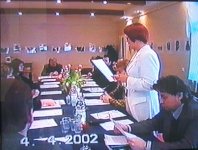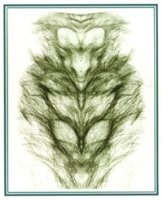|
Angel Drawings ResearchOn april 4, 2002, dr. Vladimir Sivitsky organised an exhibition of Aster's Angel Drawings in the Maxim Bogdanovich's Literary Museum (Minsk, Belarussia) and invited several prominent scientists to discuss the pheonomenon of ideomotoric drawing. Prof. Dr. Tamara Alpeeva
"Is it sensible to show these automatic drawings to the public ?"We would like to thank you for your attention. As for todays plan, first of all mr. Sivitsky is going to make you acquainted with the general idea of the creations of the author (Aster) and the process of the work as he defines it, transcendental ideomotor automatic drawing. In simpler terms, though not in concept, the author calls his work Angel art and his drawings, 'Angel drawings'. Mr. Sivitsky will also tell you about scientific research in the field of automatic drawings and automatic writings, and about the history of the relations with the author. It is of great importance that there is a laboratory in the institute performing researches in this area. "Should we see Asters Angel drawing as a representation of negative powers ?"After that we have a possibility of watching a film about the process of Asters work, the way his angel drawings are being created and the atmosphere about it. After that we propose to discuss a number of questions. Ofcourse the scale of the questions is very broad so we decided to make a selection. We propose the following themes for the discussion : psychological aspects of ideomotorics, influence of ideomotorics on the consciousness of other people, can a trancendental ideomotor angel drawing be considered a piece of art, why do some visitors of the exhibition feel negative and disruptive influences and something evil coming from them, is it sensible to show these angel drawings to the public and last, should we see it as a representation of negative powers ? Looking inside the subconscious.Psychological aspects of ideomotorics, influence of ideomotorics on the consciousness of other people, these things are burried under our consciousness and not getting out that easy. In the state of changed consciousness, in the trancendental state, we can look inside our subconsciousness, see the secret parts of our consciousness, and also look outside; so from this perspective ideomotorics is a good platform for research from the point of view of our analysis. This way we can look inside our subconsciousness, which is very important from a scientific point of view. Is this a piece of art?
There is another perspective. Is this a piece of art? This is another question we would like to discuss. Popculture is replacing the idea of art itself; we see everything as a culture at the moment. But on the other hand we all understand that not everything that’s written is a poem and not all the sounds we are getting out of musical instruments is music, and of course not everything what can be put on a piece of paper is art, is a drawing or a painting. That’s why we also invited representatives from the arts community, and we would like to talk about the evaluation of these pictures, from the point of view of art. Negative and disruptive influences.There is another aspect, a third aspect we would like to discuss, if you read the book containing the opinions of people who came to see this exhibition, they’re telling also about negative influences coming from the drawings, about disruptive influences coming from them, something not good coming from them. So this is another point we would like to discuss. Yes, some people liked and some people didn’t like it. But everyone experienced some emotions. So impulses are getting deep inside us and evoke emotions. These emotions and feelings can be of different kind. They can be positive or negative, as we can see from one of the messages we found in the book written by one of the visitors of the exhibition. So the question is if it is sensible to show these paintings to the public or maybe it’s not a good idea. Or maybe if we see it as a representation of negative powers it could free our consciousness from these negative parts and give us space for good emotions.
|